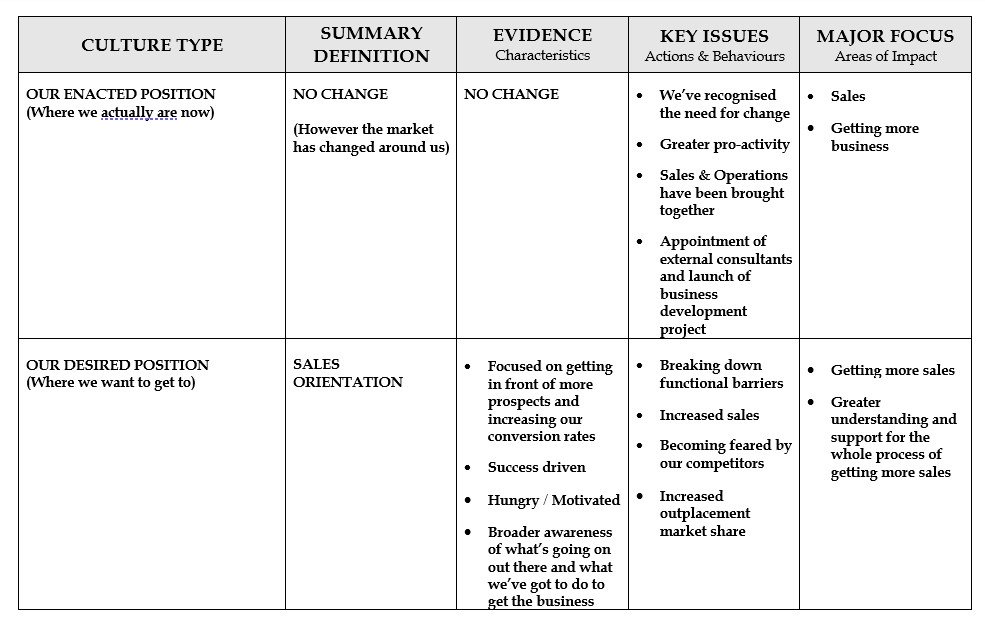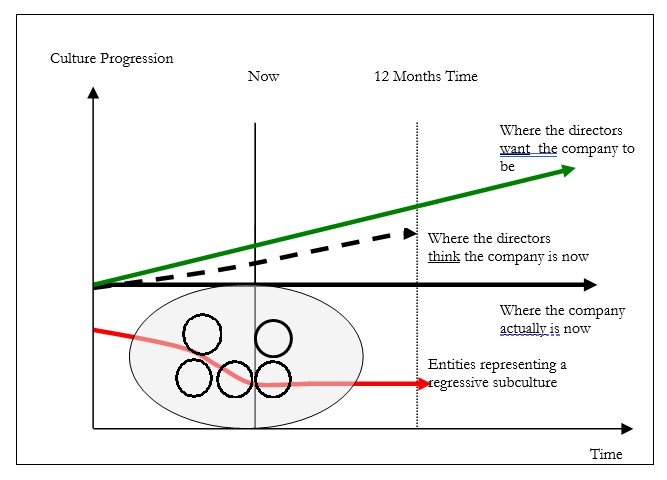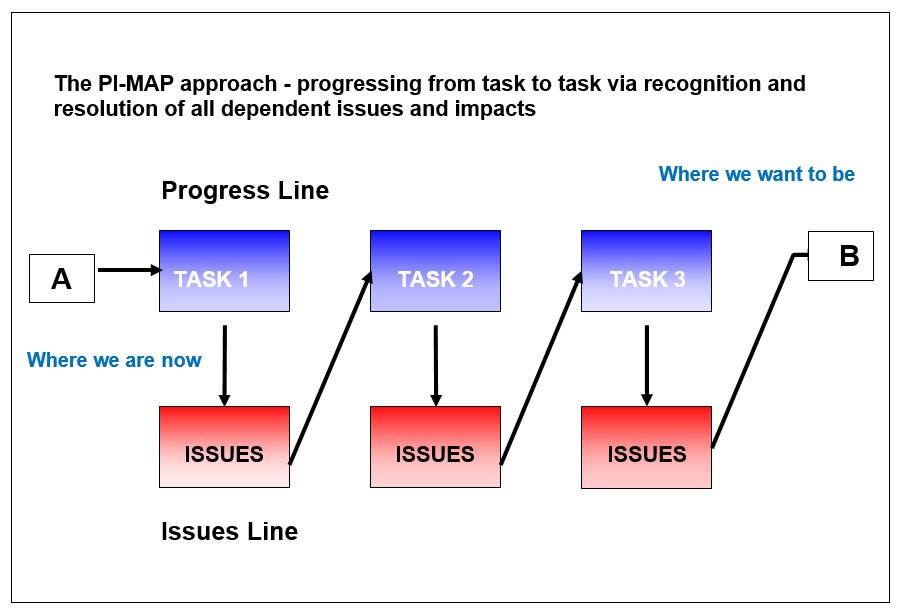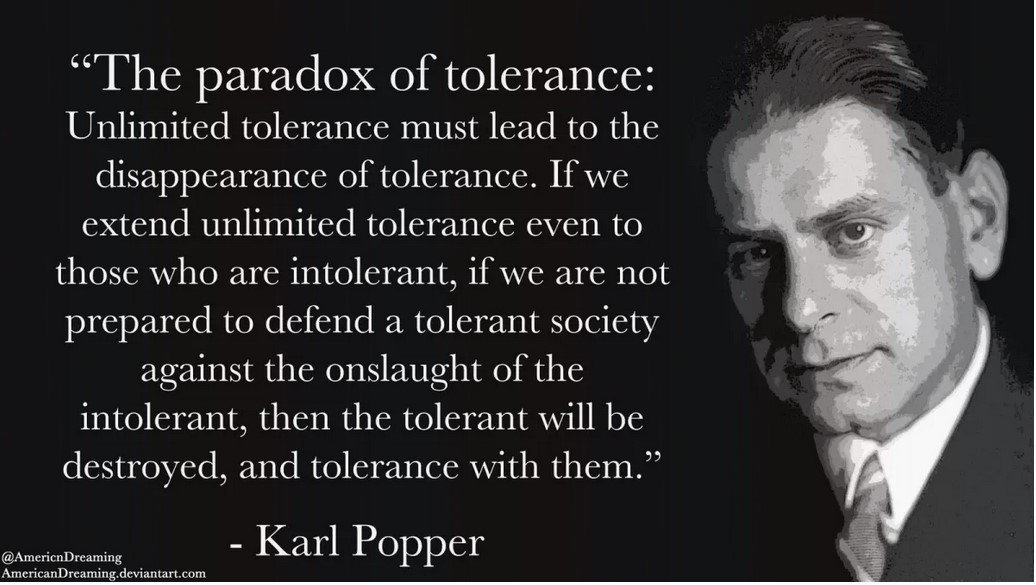Group Culture
The Invisible Software That Rules Your Life

What Is Group Culture?
As social creatures we spend the majority of our time in the company of others, either by choice with our friends or by default with our families and employers.
We like to see ourselves as free agents making our own choices and living authentically but the reality is that The Matrix has many layers and we are unaware that we are more enmeshed and ensnared than we realise.
We are, to a very large extent, governed by our conditioning and our hardwired cognitive biases. Group
culture is another one of those things that also has a very powerful
influence on our thought processes, decisions and behaviours.
Group culture is:
- Shaped - by the spoken or implicit goals and objectives of the group
- Defined - by the primary focus of the key players in the group
- Evidenced - in observable behaviours and actions that demonstrate (a) the real agendas of the key players and (b) those things that receive the most attention in this culture
- Invisible - to those within the culture
- A Filter That Distorts - how information is received and processed
- A Hidden Operating System - that will determine how people behave
Why Does Group Culture Matter?

Group culture matters because it is the invisible software that determines individual behaviour in a group context.
- It applies to your family group, your church group, your club group, your place of employment, it applies to your country.
- It applies to any and every group that you belong to and attend regularly.
It also matters because the fabric of your life, and the lives of everyone you interact with, consists of membership and participation in multiple groups. You move seamlessly from group to group everyday:
- You start the day with those you live with
- You enter and engage with your working life
- You go to clubs, societies and group activities in your free time
- You engage online with a range of forums and communities; and
- You do all this within the country in which you live
Each of these groups have their own cultures which to a significant degree influence and determine how you think and behave.
This is the invisible software that, to a surprising degree, rules your life.
Recommended reading:
Herd Mentality and How To Avoid It
Social Contagion - You Become The Company You Keep
The impact of group culture on communication, persuasion and change

This article is posted in the context of a series of articles on Communication Persuasion And Change and it is important to understand that:
- You can not communicate or persuade effectively without taking account of group culture
- You can not instigate any type of significant change without taking full account of group culture
- You will may need to change the group culture
- In attempting to do any of this you need to understand that group culture is the source of much “hard-wired” resistance to change
- You will almost certainly fail unless: [a] you are the leader of the group, or [b] you have the sponsorship and full support of the leader of the group.
A Reality Check and A Health Warning! I have used the templates and tools outlined in this article on many occasions in my business career, and they work very effectively. BUT, and this is big but, very few clients understood or were interested in group culture. There were a few who did and I used these processes overtly and as described in this article and in the attachments. But for the majority, all they wanted was results and frankly they didn't care how I did it as long as I got results, so I used these processes covertly. The greatest value in what I am sharing in this article is the insight and knowledge it will give you in understanding:
Sub-cultures
There are most likely several sub-cultures within a group culture.
These can exist within an entity as small as 2 or 3
people or a much larger group such as a department or functional group, or a whole organisation.
It usually evolves around and is focused on a specific function, or a strong personality or dominant individual, or it maybe an ethnic group or a group with shared interests and activities.
In this article I am sharing a simplified view of understanding group culture and therefore I don't cover this, but if you are interested in understanding the importance of sub-cultures in the dynamics of group culture, please see the full business version of this model and the real-life example.
How to change a group culture
To change a group culture, you need:
- To identify it and understand it
- A framework and language to communicate it
- Tools and processes to change it
The Components Of Group Culture
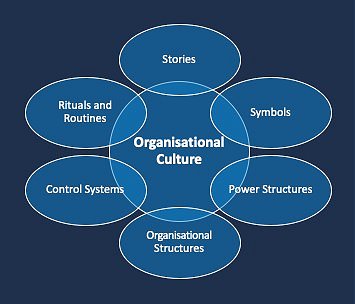
There are a number of cultural analysis models and a popular model is the Johnson and Scoles Cultural Web.
Over
many years in management consultancy and interim management I developed
my own model which proved effective with many clients.
You can download a free report on the full business version of this model here and a real-life example of a cultural mapping and analysis of a HR company
This is not a business seminar so I am going to present these ideas here in a simplified format.
Cultural Framework Template
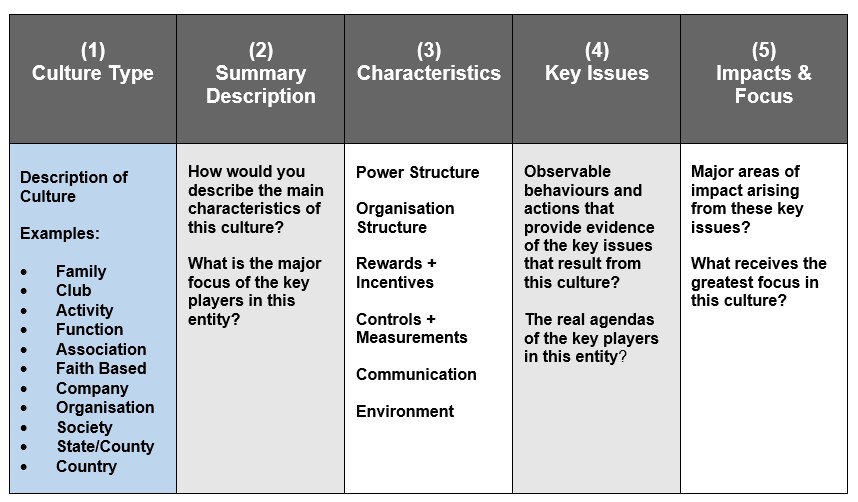
[1] Culture Type
This is simple description of the type of group you are describing or analysing.
For example, is this group a family, a social group or a business etc?
N.B. In the business version of this model we go into this in more depth and identify:
- The different types of dominant [overall] organisational culture,
- The sub-cultures that always exist in any organisation, and
- The interaction and dynamics of these different cultures.
[2] Summary Description
This is a brief description of the main characteristics of the culture - the look and feel of "how things really are".
It also describes the main focus of the key players in this group.
For example, in the case of a business:
- "The message is that we do things the cheapest way we can."
- "There's lots of talk about money, and especially about how to cut costs."
[3] The Characteristics of the Culture
This can include things such as:
# Power Structure - Who exercises power? What are the sources of power? These structures can be formal – the CEO and Board of an organisation. Heads of Government and various Institutions of State. Or they can be informal – a religous leader, a parent or a person of strong influence [a pressure group] or in an organisational context perhaps a strong trades union leader
- "The CEO believes in engaging staff very widely in decision making on all key issues."
- "Hmmm some people have special access to the senior management team."
# Organisational structure: Defines how people are managed and how they interact. In an organisation there will always be a formal structure. But in social groupings the structure may be more informal and adhoc and be based around those with greatest social influence.
- "There’s a flat structure – at all staff meetings everyone can speak up."
- "There are no PAs or support staff, so everyone is self managing."
# Rewards & Incentives - these can be financial - such as salaries, bonuses, commissions and profits; or they can be non-financial such as approval, prestige, influence and social standing.
- "Employees docked pay if their quotes/estimates are more than 10% out."
- "The threat of docked pay keeps mechanics working with this model."
# Controls & Measurements - How are behaviours and outcomes measured and monitored? What are the standards and values?
- "The owner believes in a low cost, high-profit model, and is prepared to lose repeat customers."
- "Costs are highly controlled, and customers are billed for parts down to the last screw."
- "Quality is not emphasized. Getting the work done with the least amount of direct costs is the goal."
# Communications - Who? What? When? How? Why?
- "The CEO believes in engaging staff very widely in decision making on all key issues."
- "There’s a flat structure – at all staff meetings everyone can speak up."
# Environment - What are the working or regular routines? What is the style and atmosphere? What are the Myths, Symbols and Legends that encapsulate "who we are"?
- "Staff members talk about the founders starting the company from home with £500."
- "The whistleblowing code is widely respected and used – anyone can challenge anything."
- "Employees are expected to work very long hours without complaint or overtime."
[4] Key Actions and Behaviours That Show The Real Issues?
What are the observable behaviours and actions that provide evidence of the key issues that result from this culture?
- For example: in a business with a production
culture these might be cost control, and quality relate issues;
- In a religious family these might be to do with conformity of beliefs and values
What are the real [as opposed to the espoused or claimed] agendas of the key players in this entity?
- This will be apparent in the observable behaviours and actions of the key people.
- The key question here is: Where are the areas of "talk-walk gap"? [Where do they preach one thing but do another e.g. George Orwell's "Animal Farm".]
[5] Major Areas of Focus - Areas of Impact
What are the major areas of impact arising from the key issues?
What receives the greatest focus in this culture?
- For example in the business with a production
culture the major focus will be on doing whatever it takes to satisfy existing
customers, developing and maintaining distribution relationships, understanding
wider market factors and their impact on production processes will be the main point of focus.
- In the religious family the major focus will be on conformity and compliance with group beliefs and values, ensuring full compliance and adherence to all religious duties and practices, and maintaining the purity of the faith i.e. no heresy or apostasy.
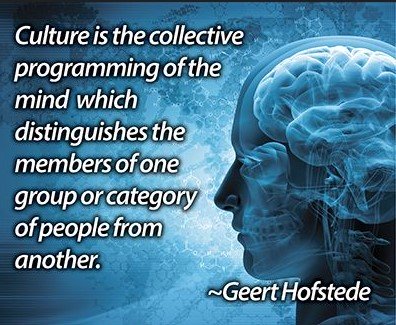
How To Change A Group Culture
"The Last Samurai" - Final Battle
To
change a group culture there are a number of simple but critical steps you need to undertake. You will need:
- Sponsorship and support from a group leader
- Buyin from influential informal [unappointed] leaders
- To understand the current culture and how you want it to be
- A framework and language to communicate this
- A simple structured process to make the change
[1] Sponsorship, support and buyin

Regardless of the size of your group, you will be wasting your time unless you have the positive support of a group leader to mentor and sponsor your culture change initiative.
The existing group culture will be largely the product of the leadership style, personality and policies of the leader so it essential that you gain their support to provide the energy and momentum to get the rest of the group to take this seriously.
In addition to this there will be people of influence in your group whose buyin and support you need. Whilst they are are not part of the formal leadership structure of your group they carry weight and have considerable social influence, so they are worth having onside.
Gaining this support and buyin will require you to exercise the art of persuasion and advanced communication skills .
To repeat, this first step is critical because without it you can not succeed and you will be wasting your time.
[2] What do we look like now, and what do we want to look like in future?
Cultural Framework Template
Using and adapting the Cultural Framework Template above undertake a situation analysis to create a cultural framework for your group that clearly and accurately describes "Where we are now".
This template can be simplified or expanded depending on the size and complexity of your group. Also, feel free to amend and adapt it.
The point and purpose of a cultural framework template is to create a visual framework and language - supported with tangible evidence - to enable everyone involved to be able to communicate in an unemotional and non-confrontational manner.
This is undertaken through a series of facilitated sessions held with those who will be impacted by the proposed changes.
The objective is to reach a shared understanding of:
- This is what we look like now.
- This is what we want to look like.
[3] Where are the gaps between where we are now and where we want to be?
Gap Map
With reference to the two cultural frameworks you have created, working with your team you need to identify all the gaps - all the things that will need to change - to enable you to create the desired culture.
This is all about specifics and tangibles.
The objective is to end up with a categorised list of all those things that will need to change.
Do not get hung up about the issues involved or the resistance you may encounter. These will be addressed thoroughly in the next stage.
Please note: The "Gap Map" above is a real-life illustration of a culture mapping exercise I conducted with an outsourcing consultancy. I have shown this for illustrative purposes only.
You do not have to create a gap map in this format to benefit from a gap analysis. All that matters is that you identify all the gaps and you represent them in a simple clear format that everyone in the group can recognise.
[4] Establishing a simple structured process to make the changes
The Progress And Issues Map
The typical approach to initiating any major change, whether in personal life as an individual or as an organisation, assumes that it can be treated as incremental change and accommodated within "business as usual".
But of course this approach assumes too much and overlooks basic success-critical steps.
I have created and successfully used a tool,
illustrated above,
that I call a PI-MAP [Progress and Issues Map] which is visual reminder to undertake these steps and with each task to ask yourself [and your team if you are applying this to an organisation]:
What issues and impacts have to be resolved to successfully move on to the next task with confidence in a successful outcome for the whole initiative?
The whole process is described here:
The Discipline of Considering Impacts Before Rushing Into Action
This process is simple but powerful and is so often skipped in a rush to "get things done". You can apply this process to any and every situation where you have a series of important tasks to accomplish in the pursuit of a major goal. This applies in personal life as well as in organisations.
The Minority Rule
In our analysis and consideration of group culture in this article I have repeatedly said that unless an initiative to change a group culture has the support and empowerment of the formal and informal leaders it is doomed to fail.
So perhaps this provides a clue as to how we have fallen prey to intolerant minorities.
At the societal level, tolerant, flexible and accommodating societies do not have strong formal or informal leaders controlling and enforcing the society's shared beliefs and values [because to do so would be intolerant and inflexible].
So when an intolerant minority is present in a society where the majority are flexible and accommodating, and have no strong values-based leadership, there is an asymmetry in choices.
This means that the flexible, tolerant majority accept the intolerant minority position but the intolerant minority do not reciprocate.
The outcome of this is that rather than the minority being assimilated into the flexible majority, the flexible majority become assimilated into the inflexible minority!
I have found the work of Nassim Taleb, based on complex systems theory, particularly helpful in explaining how this happens:
This, of course, does not happen in less flexible religious societies such as Islamic Malaysia and less flexible secular societies such as Singapore.
How complex systems theory provides a powerful counter to prevailing assumptions espoused by intolerant minorities
Unlike some of the theories that have come to prominence over the past 10-15 years and that have fueled intolerant minorities, complex systems theory is multidisciplinary and science based.
It provides an alternative paradigm to the simplicity and erroneous assumptions and extrapolations of reductionism.
Complex systems theory's primary focus is on understanding the dynamics and interactions of a system's parts and how these interactions give rise to the group's collective behaviours.
Nassim Taleb explains this succinctly [I paraphrase]:
- The main idea behind complex systems theory is that the group behaves in ways not predicted by the behaviour of individuals within the group.
- The interactions within the group matter most and are the determining factor in group behaviour.
- The group actions and behaviours that arise from these interactions are referred to as an “emergent property" of the group.
- These interactions can obey very simple rules and in this context this is the "minority rule".
This matters enormously because intolerant minorities cite examples of individual behaviour [often in unfortunate or tragic circumstances] that are promoted via mass media and social media as typical of society as a whole.
To be specific:
- The tragedy of George Floyd's death is not a metric of racism in US society or in the US police.
- The behavior of Lady Susan Hussey is not a metric of racism in the UK royal family.
Free Downloads:
The full business version of this group culture model and analysis
How to measure the value of an organisation's culture.
Further Reading:
Persuasion
[1] The Art Of Persuasion The One Fundamental Principle - Create A Win-Win
[2] The Art Of Persuasion Advanced Communication Skills - Gaining BuyIn
[3] The Art Of Persuasion Planning For Success - Here's How To Do It!
Change
Getting From A to B Is Not Aways A Straight Line
Group Culture - The Invisible Software That Rules Your Life
Change Questions To Change Your Outcomes
Communication
How To Influence without Authority - 6 Key Tips
Third Party Resource:
Why Company Culture is Culture Important? (with Examples)
Return from "Getting From A to B" to: Communication Persuasion and Change
Or to: Walking The Talk
LATEST ARTICLES
The Battle For Your Mind - How To Win Inner Freedom In A Digital Age Of Distraction
 From External Events to Inner Events. We often think of “events” as things that happen out there: the traffic jam, the rude comment, the delayed email reply. But what truly shapes our experience is wh…
From External Events to Inner Events. We often think of “events” as things that happen out there: the traffic jam, the rude comment, the delayed email reply. But what truly shapes our experience is wh…How to See Your Thoughts Without Becoming the Story
 A Practical Guide to Thought-Awareness. You can spend your life inside the stories of your mind without ever learning how to see your thoughts clearly and objectively. Most of the stuff we tell oursel…
A Practical Guide to Thought-Awareness. You can spend your life inside the stories of your mind without ever learning how to see your thoughts clearly and objectively. Most of the stuff we tell oursel…The Collison Decision Matrix - A Simple Framework for Better Choices
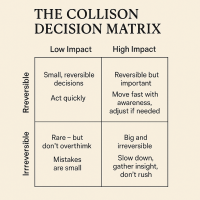 The Collison Decision Matrix Is A Practical Everyday Thinking Tool. Most of us spend a surprising amount of time worrying about decisions. From small ones such as what to wear, what to eat, what to te…
The Collison Decision Matrix Is A Practical Everyday Thinking Tool. Most of us spend a surprising amount of time worrying about decisions. From small ones such as what to wear, what to eat, what to te…The Power Of Asking The Right Question
 The Power Of Asking The Right Question Lies In The Quest For Insight. To experience the power of asking the right question you must develop the practice of asking questions. The best way to improve th…
The Power Of Asking The Right Question Lies In The Quest For Insight. To experience the power of asking the right question you must develop the practice of asking questions. The best way to improve th…Site Pathways
 Here is a site pathway to help new readers of Zen-Tools navigate the material on this site. Each pathway is based around one of the many key themes covered on this site and contain a 150 word introduc…
Here is a site pathway to help new readers of Zen-Tools navigate the material on this site. Each pathway is based around one of the many key themes covered on this site and contain a 150 word introduc…How To Live With Contradiction - Beyond Thought Let Stillness Speak
 A major impact on so many peoples' lives is the situational contradiction of unfilled realistic expectations. So where does all this leave us? Well here we are, with mental equipment that is more lim…
A major impact on so many peoples' lives is the situational contradiction of unfilled realistic expectations. So where does all this leave us? Well here we are, with mental equipment that is more lim…How To Trust The Process Of Mindfulness - Right Now
 In mindfulness, the process isn’t some distant goal — it's what is happening right now. When we talk about how to trust the process of mindfulness the credibility of the process is heavily dependent…
In mindfulness, the process isn’t some distant goal — it's what is happening right now. When we talk about how to trust the process of mindfulness the credibility of the process is heavily dependent…Inner Mastery For Outer Impact - Mental Clarity For Effective Action
 Insights only matter if they translate into consistent action. In a world crowded with quick fixes and motivational soundbites, the theme “Inner Mastery for Outer Impact” calls us to something more e…
Insights only matter if they translate into consistent action. In a world crowded with quick fixes and motivational soundbites, the theme “Inner Mastery for Outer Impact” calls us to something more e…The Wise Advocate - Helping You Achieve The Very Best Outcome
 The focus of your attention in critical moments of choice either builds or restricts your capacity for achieving the best outcome. When we talk of 'The Wise Advocate' its easy to think of the consigl…
The focus of your attention in critical moments of choice either builds or restricts your capacity for achieving the best outcome. When we talk of 'The Wise Advocate' its easy to think of the consigl…Trust The Process - Beyond The Cliche
 The phrase "trust the process" has become a cliche, the woo-woo mantra of the "self help" industry. Those three little words feel like they ought to mean something useful but hidden behind them are a…
The phrase "trust the process" has become a cliche, the woo-woo mantra of the "self help" industry. Those three little words feel like they ought to mean something useful but hidden behind them are a…The Dopamine Delusion - Why Anticipation Beats Achievement
 The thrill we feel is not in the having, but in the wanting. The more we have, the more we want. The more things we acquire and the easier things get for us, the more discontent we feel. The more spo…
The thrill we feel is not in the having, but in the wanting. The more we have, the more we want. The more things we acquire and the easier things get for us, the more discontent we feel. The more spo…The Power Of Silence Is Experienced In Your Use Of Language
 Practise the "Beneficial Neurological Delay" for optimal comprehension. The power of silence is experienced in your use of language, specifically: - How you formulate the words you use to think and in…
Practise the "Beneficial Neurological Delay" for optimal comprehension. The power of silence is experienced in your use of language, specifically: - How you formulate the words you use to think and in…

